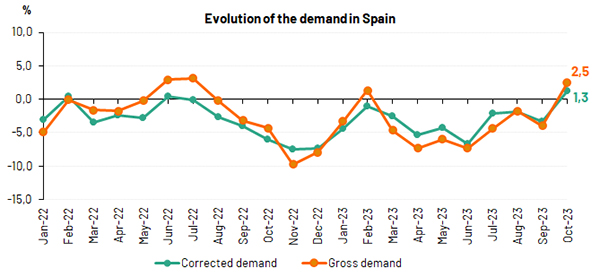For 40 years, we've been driving our country's economic and social progress. Four decades shaping Spain.
Demand for electricity in Spain grew 1.3% in October
- 50.7% of electricity production during the month came from renewable sources and 69.8% was obtained using zero-carbon energy technologies.
- Wind power was the leading technology in the generation mix in October producing 28.1% of the total.
- On 20 October, renewable energy in Spain registered a new generation an all-time high with a 70.5% share of the generation mix; a record that was beaten yesterday, 2 November, with a share of 73.3%.

National electricity demand in October experienced a 1.3% increase year-on-year after having factored in the influence of seasonal and working patterns. In gross terms, demand is estimated at 19,806 GWh, up 2.5% on October 2022.

In the year to date, Spain has registered a cumulative demand of 203,428 GWh, 3.5% less than in the same period in 2022. Once again, after having factored in the influence of seasonal and working patterns, demand fell by 3% year-on-year.
In October, according to data available at the time of this press release, renewables generated 50.7% of the total electricity produced nationwide. Renewable technologies produced 10,609 GWh during the month, an increase of 25.5% compared to October 2022.
The production values registered by renewables this month were mainly due to the contribution of wind power, which increased its monthly production by 15.4% compared to October 2022, with 5,888 GWh, representing 28.1% of the total generation mix, a share that made it the leading technology in October.
Additionally, solar photovoltaic energy accounted for 2,566 GWh in October, a value that is 26.7% more than in the same period the previous year. The share of solar photovoltaic generation in October represented 12.3% of the total generation mix.
Furthermore, 69.8% of the month's electricity production was obtained using zero-carbon energy technologies.

October was also a month in which Wind enabled new record highs in terms of its share of production: first off, on Friday 20 October, it reached its highest daily share of renewable production in the generation mix, nearly 70.5%. This record was again broken yesterday, 2 November, registering a new record share of renewables in the daily generation mix that accounted for 73.3.
It should be noted that wind power reached its highest share in the national daily generation mix on 26 October, accounting for 54% of all electricity produced in Spain on that day.
Demand for electricity in the peninsular system
Regarding the mainland electricity system, and after having factored in the influence of seasonal and working patterns, demand for electrical energy in October was 0.8% higher than the same month in 2022. In gross terms, demand stood at 18,456 GWh, up 2% year-on-year.
In the first ten months, electricity demand on the Spanish mainland stood at 190,601 GWh, a 3.8% decrease compared to 2022. Again, after having factored in the influence of seasonal and working patterns, demand fell by 3.2%.
Renewables as a whole generated 53.1% of the peninsular total and 73.5% of the electricity was obtained using zero-carbon energy technologies.
Electricity demand in the Balearic Islands and the Canary Islands
Electricity demand in the Balearic Islands in October, after having factored in the influence of seasonal and working patterns, was 4.9% higher than in the same month in 2022. Thus, gross monthly demand is estimated at 499,028 MWh, 6.9% up on that registered in October 2022. In the first ten months of 2023, gross demand in the Balearic Islands is estimated at 5,203,371 MWh, down 1.5% year-on-year.
In terms of generation, combined cycle, with 68.8% of the energy produced in the Balearic Islands, was the leading energy source in the islands in October. For its part, renewable energy obtained using zero-carbon energy technologies in the Balearic Islands, increased by 30.3% compared to the same month last year and represented 12.4% of the total.
In addition, during October, the subsea link between the mainland and Majorca contributed to covering 26.4% of the electricity demand in the Balearic Islands.
For its part, and after having factored in the influence of seasonal and working patterns, electricity demand in the Canary Islands increased by 9.8% year-on-year. In gross terms, demand stood at 817,021 MWh, up 12.1%. So far this year, annual cumulative demand in the Canary Islands is estimated at 7,295,363 MWh, up 2.6% compared to the same period in 2022.
In terms of electricity generation in the Canary Islands, combined cycle, with 49.3% of the total, was also the leading technology in October, while renewables and generation obtained using zero-carbon energy technologies produced 11% of the production this month, with wind generating 7.2% of the total.
Consult our Daily Balance Report for more information on the National, Peninsular, Balearic Islands and Canary Islands electricity systems as at the close of October.
Downloads










